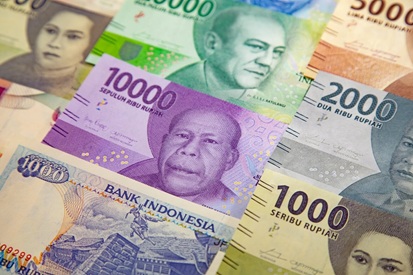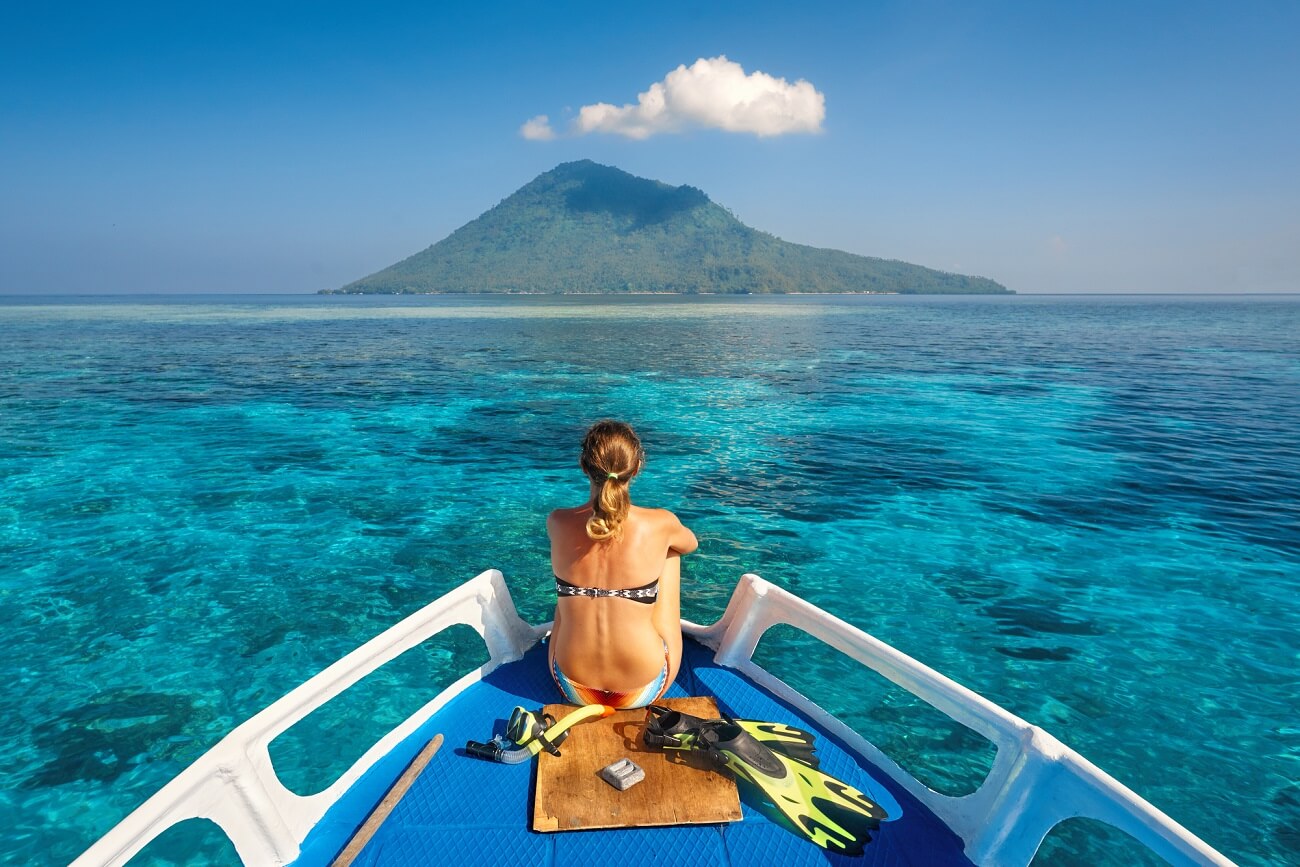

Perhaps the most unusual island state can be considered Indonesia. The country is scattered across the islands of the Malay Archipelago and the western part of New Guinea. It is washed by two oceans - Pacific and Indian. Tourism is well developed on the Indonesian islands. This is the largest country with incredible tropical nature. In total, there are about 17,800 islands in Indonesia, of which only 6,000 are inhabited.
General characteristics:
- Country: Indonesia
- Capital: Jakarta
- Area: 1,919,440 km²
- Population: 270 million 203 thousand
- Language: Indonesian
- Religion: Islam (88%)

Depositphotos
Interesting facts about Indonesia
- The largest Muslim country in the world.
- The largest island state, which includes more than 17 thousand islands.
- In terms of population, Indonesia ranks 4th among the world's countries, after the USA, China and India.
- One of the main producing countries of peanuts, which can often be found in Indonesian national dishes.
- The main language on the islands is Indonesian, but more than 700 dialects are used in everyday life.
- There are over 400 volcanoes in Indonesia.

Depositphotos
Republic name
In the literal sense, Indonesia means "island India". The state received such a name only in the 18th century, after the inhabitants of the Malay Archipelago were mentioned in the works of the British ethnographer George Windsor as Indonesians. Previously, the islands of Indonesia were a colony of the Netherlands East Indies.
History of Indonesia
The history of Indonesia began along with the first hints of the development of mankind, since it was on these islands that the remains of the first ancient man, Pithecanthropus, or Homo erectus, were found.
In the 17th century, the islands of the Malay Archipelago became the object of research by scientific expeditions. Sea routes were established and trade was actively developed. During this period, the flesh until the middle of the 20th century, Indonesia was part of the Netherlands (Dutch) colonial empire.

Depositphotos
Ancient period
According to scientists, the settlement of the Indo-islands by representatives of the homo species sapiens began about 45,000 years ago. Although, according to studies of ancient remains, the Javanese ape-man lived in Sumatra about 73 thousand years ago. Most modern Indonesians are descended from Deuteromalays - representatives of the Bronze Age.
1st to 15th century
The first developed state to be extended over several islands was Shvirijaya, founded in Sumatra in the late 7th century AD. The state included most of the island of Java, Sumatra and the Malay Peninsula. In these territories, Indian culture prevailed, the main religious directions were Hinduism and Buddhism. In 1293, the most economically and socially most civilized Majapahit empire was founded on the island of Java, which brought together most of modern-day Indonesia. Since the same period, Islam has been spreading on the islands.

Depositphotos
16th to 20th century
From the 16th century, the era of colonization began in the history of the Indonesian islands. For some period between the Portuguese and the Dutch, there was a struggle for ownership of local plantations of spices and spices. In 1602, the Netherlands East Indies Colonial Company was not founded. The operation of the colony was based on economic ambushes. Coffee, tobacco, sugar, indigo and valuable timber were grown here. The company existed until the beginning of the 19th century. Great Britain took the place of the colonial owner, and a few years later the Netherlands again, under the terms of the London Convention of 1814. At the beginning of the 20th century, the first national liberation movements were organized in the colony, which fought for the independence of the islands. During the years of World War II, from 1942 to 1945, the Netherlands East Indies was under Japanese occupation.
Period of Independence
Indonesian independence was proclaimed in 1945. The national hero Sukarno became the first president of the state. The sovereignty of the Republic of Indonesia was not recognized by the Netherlands for a long time. In this regard, a military conflict arose, which continued, with some periodicity, until 1949. Since the middle of the 20th century, more than one political crisis has happened on the islands. Ultimately, the New Order Party gained a foothold in power, which led to a significant development of the economy.
Today, Indonesia is a presidential republic with the People's Consultative Congress as the highest legislative body. The state is divided into 32 provinces, one of which is the western part of the island of New Guinea.

Depositphotos
Geography of the islands of Indonesia
The islands are scattered across the expanses of water for hundreds of thousands of kilometers. The Malay Archipelago is located on both sides of the equator and is washed by two world oceans. Therefore, Indonesia is the largest island state in the world and the largest country in Southeast Asia by area. Indonesia includes over 17,000 islands of various sizes. Among them, only 6 thousand have a permanent population. A significant part of the land is divided into Large (Java, Sumatra, Sulawesi, Kalimantan) and Small Sunda Islands.
State borders of Indonesia
On the land
- with Malaysia
- with Papua New Guinea
- with East Timor
On the water
- with Malaysia
- with Papua New Guinea
- with East Timor
- with Singapore
- with the Philippines
- with Australia
- with India

Depositphotos
Climate and weather in Indonesia
The islands have an equatorial climate, with hot, mostly dry summers and rainy winters. The air temperature at any time of the year ranges from +25 to +33°C. For holidays in Indonesia, it is better to consider a dry, sunny period - from May to September.
Nature of Indonesia
The islands of the Malay Archipelago are famous for their unique nature with evergreen forests, ancient lakes, pristine beaches, rich flora and fauna. Nature is the very feature that makes Indonesia so popular for recreation. In particular, many tourists flock to the world-famous volcanic island of Bali. But besides him, there are many other amazing places in the tropical expanses of Indonesia.
Here you can appreciate the splendor of untouched tropical beauty, explore mountain routes, dive into magical underwater caves, meet extraordinary inhabitants of the tropics and enjoy the uniqueness of volcanic beaches.

Depositphotos
Religion in Indonesia
Mainly, the development of Indonesian culture was influenced by three religious directions - Buddhism, Judaism and Islam. Therefore, the islands are characterized by a mixture of different currents. Catholicism and Protestantism, according to the Constitution of Indonesia, are also official religions. Hinduism is widespread on the popular resort island of Bali. But, in general, about 88% of Indonesians adhere to Islam.
Regardless of which island you find yourself on, in public places, especially when visiting shrines, it is recommended to cover your shoulders and knees with clothes. Hindu temples can only be entered without shoes.

Depositphotos
Culture of Indonesia
Culturally, Indonesia is a universal country with an incredible contrast, which is created by about 300 nationalities. From modern cities like Jakarta to huts and shacks on islands remote from modern civilization. In all corners of the vast archipelago, the cultural spirit of the Indonesians is felt. Holidays and festivals are always very bright and memorable. The contemporary art of local masters of painting can be seen both in large galleries and on the streets. And the traditional crafts of real islanders reflect the whole gamut of folk art, in all its manifestations.

Depositphotos
Folk crafts
In Indonesia, you will come across several handicraft destinations. You will definitely want to buy many products as souvenirs. Among the most interesting types of handicrafts on the islands of Indonesia:
- Pottery (Yogyakarta region). Everything from children's toys to eco-ware.
- Wood carving, in particular bobung - carved work on a mask. Typical for the regions of the central part of Java.
- Making kris, asymmetrically shaped national daggers.
- Weaving and weaving from bamboo. Most often, fruit and rice baskets, lampshades, and decorative packaging are made.
- Hand-painted on fabrics (batik). Original art, listed by UNESCO as a masterpiece of the spiritual heritage of mankind.
- Silver items. This is especially true for the island of Bali. Local decorations are distinguished by intricate designs and rich decorations. It is the works of Balinese masters that are highly valued far beyond the borders of Indonesia.
- Sarong handmade. Fabric making in Indonesia is an art practiced by local women. The painstaking process of weaving fabrics for sarongs is very interesting. The center of the practice of this craft is Bali.
- Natural spa products. Essential oils, creams and masks for body and face, handmade soap and much more. Once you try Indonesian natural cosmetics, you will not be able to refuse them.

Depositphotos
Holidays and festivals
Ethnicity to different nationalities, as well as a mixture of religions, has created an incredible flavor of national and religious holidays in Indonesia. Each of them will be interesting for colorful festivities with traditional ceremonies. Official dates include New Year, Christmas and Independence Day (August 17). Other holidays in Indonesia do not have fixed days, and are held according to the religious calendars of Buddhism, Islam and Judaism. If you are lucky enough to witness the folk festivals on the islands of Indonesia, enjoy the incredible atmosphere and vivid emotions that accompany them.
The most grandiose events that you can catch in Indonesia include:
- Art Festival in Bali (annually in June-July).
- Celebration of Independence Day in all regions of the country (August 17).
- Jax Street Festival. Held annually in July-August in Jakarta, on the street Jalan Jax.
- Bali Food, Coffee and Fashion Festival (annually in October).

Depositphotos
Indonesian cuisine
Indonesian cuisine is incredibly diverse. Its culinary traditions are characterized by an unusual combination of different ingredients and a spicy taste with many spices. Regionally, the national cuisine of the islands can be divided into Javanese, Peranakan and Padangese. During the development of the peoples of the Malay Archipelago, traditional cuisine has been influenced by the culinary traditions of many other countries and regions, in particular Indian, Chinese, Arabic and Dutch. Indonesia's gastronomic offerings can be so diverse that it is unlikely that you will be able to try half of what is offered in one vacation.
The basis of Indonesian cuisine is rice, chicken, noodles, potatoes and other vegetables, fish, and seafood. Common national dishes of Indonesia, which can be found on almost all islands:
- Krupuk. A kind of chips that are made from starch, flour, or chopped squid, fish, shrimp.
- Soto. Soup with rice vermicelli, meat, beans and cabbage. The aromatic broth is flavored with lemongrass, garlic, turmeric, and other spices.
- Rendang. A spicy meat dish of lamb or beef. For its preparation, chili peppers and coconut milk are used.
- Batagor. Fried tofu with fish meatballs. To complement the taste, batagore is served with lime juice and peanut sauce.
- Mi Ayyam. Traditional Indonesian noodles that are on the menu of every restaurant. In addition to it, there is always fried chicken or bakso (meat or fish meatballs). Garlic and soy sauce add a sweet-salty taste to the dish.
- Sate. Marinated meat on wooden skewers, which is cooked on coals. Depending on the region, different types of marinades, different types of meat, fish, and a variety of sauces are used in cooking.
- Naxi Goreng. Fried rice is the foundation of Indonesian cuisine. Finely chopped fish, sausage, chicken or other meat can be added to it.
- Gado-Gado. Light salad, most often steamed. It consists of spinach, fried tofu, bean sprouts, corn, cucumber, boiled potatoes and an egg. Vegetarian salad dressed with creamy peanut sauce.
- Tongseng. Beef or lamb stew with coconut milk and spicy spices.

Depositphotos
National currency of Indonesia
The Indonesian rupiah (IDR) operates on the islands. Upon arrival in Indonesia, you can exchange funds for local currency at all banks, at special windows at the airport, at hotels and exchange offices in the markets. The latter offer the most unfavorable rate, so it is best to find an exchange office immediately upon arrival, at the airport.
In large resort areas, euros, dollars and the currency of Southeast Asian countries are often accepted for payment. To pay in small shops and hotels you need rupees, in large supermarkets and hotels credit cards are accepted.

Depositphotos
Public transport in Indonesia
The islands of Indonesia are united by sea and air transport. Transport infrastructure is well developed on the large islands. There are city buses for domestic and intercity travel and fixed-route taxis that provide mobile transportation.
By cities. Tourists prefer to rent motor rickshaws, cycle rickshaws or taxis, as city minibuses are usually very crowded. Large city buses can only be seen in Jakarta, the capital of Indonesia. Depending on the distance, the fare can range from 5 to 20,000 IDR (from 0.3 to 1.3 euros).
Intercity buses. Good bus service between major cities in Bali, Java and Sumatra. In regions more distant from the central cities, minibuses run between settlements.
Railroad. The most developed passenger rail service is on the large island of Java, as well as in the northern, southern and western parts of Sumatra.
Water transport. Indonesia is a collection of islands of a huge archipelago, so water communication plays an important role in the economic and social life of the country. There are many water routes between the islands and a ferry service has been established, which allows you to travel comfortably. There are several 24-hour ferries on the water routes between Java, Bali and Sumatra.
Cruises. Sea cruises over long distances on large passenger ships in Indonesia are a very popular pastime. One trip can last from 2 to 4 weeks. Thus, it is possible to explore the most remote corners of Indonesia with stops at ports. Numerous private boats and boats run between neighboring islands.

Depositphotos
Airports in Indonesia
On the map of the islands, you can count about 650 airports, 18 of which have international status. The largest are concentrated on the large islands of Java, Bali, Sumatra and Sulawesi. The most popular airports that receive tourist flights:
- Soekarno-Hatta, 30 kilometers from the center of Jakarta.
- Ngurah Rai in Bali, 14 kilometers from the city of Denpasar.
- Sultan Syarif airport Qasim II in the city of Pekanbaru in Sumatra.
- Adisucipto Airport near the city of Yogyakarta, Java island.
- International airport of Lombok island.
Popular airlines whose flights are served by airports in Indonesia:
- Emirates
- Singapore Airlines
- Thai Airways
- AirAsia
- Cebu Pacific Air
- Garuda Indonesia
- Qantas
- KLM Royal Dutch Airlines
- Malaysia Airlines
- Qatar Airways
- Turkish Airlines

Depositphotos
Visa to Indonesia
Citizens of most countries can visit Indonesia on a visa-free basis for a stay of up to 30 days. What, in turn, is required from tourists:
- Valid passport.
- Return tickets (or tickets to a third country).
- Booking at a hotel or hostel.
- Customs declaration issued on the plane or upon arrival.

Depositphotos
Indonesia tourism
The tourism industry is an important component of the Indonesian economy. Thanks to the unique ecosystem of the islands of volcanic origin, with evergreen jungles, stunning fauna and flora, rich underwater world of coral reefs, about 7-8 million travelers annually flock to the islands.
For a good rest on the islands of Indonesia, all the infrastructure conditions have been created, there is an excellent choice of accommodation, many stunning nature routes on land and on water that are worth exploring. The cultural diversity of the islands is no less attractive than the natural attractions.

Depositphotos
Where to stay in Indonesia
The choice of accommodation for tourists in Indonesia is incredibly diverse. Only hotels on the islands of the Malay Archipelago, there are more than 3.5 thousand. In Indonesia, it will be easy to find both a fashionable hotel with the best conditions and a budget guest or hostel. Among travelers who want to be close to nature, tree houses, authentic huts and wooden villas among the jungle and on the coast are popular.
In large metropolitan areas, you can easily book a room in a modern hotel or inn. For tourists in Indonesia, an extensive housing market has been created for every taste and budget.

Rama Beach Resort & Villas
Things to do in Indonesia
The islands have everything you need for an unforgettable vacation. Here, first of all, it is worth going in search of new impressions and inspiration. For active travelers, Indonesia is of particular value.
- beach holiday
- Diving
- snorkeling
- Sea cruises
- Hiking and cycling routes
- Yoga and Meditation Centers
- Traveling in cities and villages
- Walks in natural parks and reserves
- Inspection of ancient ruins and temples
- Modern entertainment on the water
- Mountain hikes
- Active volcano tours and more

Depositphotos
Choosing an island: what and where you can see in Indonesia
Holidays in Indonesia can be quite diverse, so the choice of place should be approached thoroughly. Take a closer look at the main points on the map to plan your travel itinerary in Indonesia.
Bali
The most common holiday destination is, of course, Bali. The island is known for its unique volcanic beaches, Hindu temples, stunning green nature with tropical thickets and rice fields. It belongs to the Lesser Sunda Islands. The most popular resort cities in Bali:
- Ubud. Nature and the old temples of Ubud impress with their uniqueness. The city is located in a mountainous area. It is considered the Balinese center of folk dances, crafts and arts. Be sure to visit the Monkey Forest and Ubud Royal Palace.
- Canggu. A charming place with an incredibly beautiful coastline with volcanic sand. Canggu is located in the western part of Bali. A great young resort that most often attracts surfers.
- Denpasar. The main city of Bali, which is located in the south, near the resort of Kuta. Convenient for recreation, as there is an international airport near the city. Here you can see the temples and get acquainted with the Balinese culture.
- Jimbaran. The fishing village with an unusually authentic atmosphere is becoming more and more popular among tourists in Bali. Jimbaran is located in the south of the island.
- Kuta. A large resort in southern Bali, which is famous for the best Asian beaches with fine white sand.
- Seminyak. Another popular resort town near Kuta. It has a very well developed tourist infrastructure with luxurious hotels, shopping centers and restaurants.
- Lovina. The main beach resort in northern Bali, known for its beautiful volcanic beach and excellent snorkeling conditions.

Depositphotos
Java
A large island between Bali and Sumatra, with a population of about 145 million people. There are three major tourist centers in Java - Yogyakarta, Surabaya and the capital of Indonesia - Jakarta. It is the cultural, economic and historical center of all of Indonesia. By the way, Java is the 13th largest island in the world. Rivers, lakes, smoking volcanoes, green jungles, ancient temples, modern cities and authentic villages. All this is placed on a large island, which you definitely won’t be able to embrace in one trip.
What is Java famous for?
- Temple complex of Borobodur (7th-9th century). It is called the 8th wonder of the world.
- The complex of early medieval Hindu temples Prambanan, which is included in the list of UNESCO sites in Indonesia.
- The cultural capital of Indonesia is the city of Yogyakarta, where many festivals, exhibitions and other events are held.
- The famous shadow theater Wayang Purvo, which has the status of a UNESCO World Heritage Site.
- Unique excursions to active volcanoes.
- Unusual flora and fauna.
- Always warm and humid weather, conducive to travel.
- Unique local cuisine.

Depositphotos
Sumatra
Sumatra can be considered a unique island, as it is divided in half by the equator. The main part of the land consists of a mountain range. A real paradise for fans of hiking and cycling routes .
What you should definitely see in Sumatra:
- Kerinci Seblat (Kerinci Seblat National park). The largest National Park on the island with unique plant and animal species. UNESCO World Heritage Site.
- Complex of Hindu-Buddhist temples Muara Jambi in Jambi province.
- Beautiful Lampuk beach with ideal conditions for relaxing on the ocean coast.
- The capital of Sumatra, the city of Medan, with a mandatory visit to the Great Mosque.
- Lake Toba. A unique reservoir of incredible size for the island.
- The village of Ambarita, home to the ancient Batak people.
- Padang is the main city of western Sumatra.
- Volcano Krakatoa. One of the most active volcanoes in the world today. Excursion in search of adrenaline.

Depositphotos
Sulawesi
A large island in Indonesia, where nature and local culture are closely intertwined with each other. The core of the island is an ancient mountain range, from which, as if grown, several peninsulas depart. This unusual shape creates many stunning coastlines with coral reefs. Diving and snorkeling in Sulawesi are considered the main attractions. In addition to scuba diving, the island has many other great opportunities to relax.
Why visit Sulawesi:
- In the capital of the island, the city of Makassar, you can see the unusual architecture of the colonial period.
- In the north of the island in the Gulf of Manado there is a unique marine park Bunaken, which stands out for its incredible variety of underwater fauna.
- In the southeast there is another unique natural park Wakatobiwhere there are about 50 attractive dive points. Jacques-Yves Cousteau liked to call Watakobi "underwater nirvana".

Depositphotos
Kalimantan
The second name is Borneo. A huge island, which is divided between three states - Indonesia, Brunei and Malaysia. Two thirds of the land belongs to Indonesia. Kalimantan mainly consists of hilly landscapes, almost completely covered with dense equatorial jungle. This is its main feature. The forests of Kalimantan are the oldest on the planet. Their age exceeds 140 million years. The dense jungle has not yet been fully explored, so perhaps this is one of the few places in the world where there are still species unknown to science.
What to do in Kalimantan? People come here for the incredible nature of the jungle, for long trips and walks along hanging trails, for views from the peaks during mountain climbing, amazing diving and visiting national parks. And also to meet orangutans, whose population is common in Borneo.

Depositphotos
Noosa Islands Tenggara
Nusa Province Tenggara is divided into western and eastern. This is a whole chain of islands stretching from Bali to Timor. The eastern part includes the islands of Komodo, Flores, Timor and Sumba. To the west are Lombok and Sumbawa. Each of them is attractive in its own way in terms of tourism. For example, guests of Bali like to visit the volcanic island of Komodo in order to see its unique ecosystem. Komodo and Flores are home to the rare Komodo monitor lizard, which can only be seen here. Underwater fauna of the Nusa Islands Tenggara is known for its huge variety of fish and corals.
Indonesia is a unique country where you can experience the whole gamut of emotions, make discoveries for yourself and be planted with pristine nature. Happy travels!

Depositphotos
More articles
- Seychelles Honeymoon Hotels: 9 Paradise Spots
- Bali's Best Eco-Hotels: Top 12 Spots
- Seychelles for outdoor activities - from diving to jungle trekking
- Why you can be deported from Bali - several main reasons
- Seychelles hotels with the best panoramic views
- UNESCO sites in Indonesia: temples, parks and other amazing places
- Yogyakarta - all about the historic city of Java
- St. Anne Island in the Seychelles
- When to fly to Seychelles: prices and weather
- The best hotels in Kuta in Bali: 15 corners



